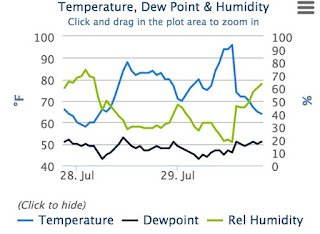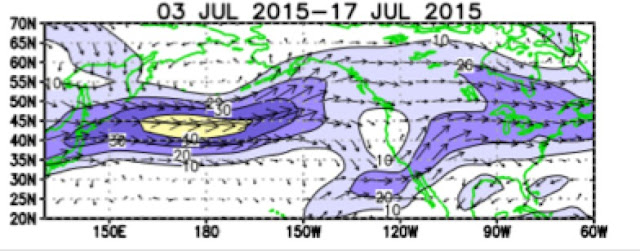Documentation of the situation is secured from the Northwest Interagency Coordination Center of the Bureau of Land Management, who graciously provided the graphs shown below. Here is the cumulative acres burned over the Pacific Northwest (Oregon, Washington) starting on January 1. The blue line is what has occurred this year. The dashed grey line is normal. The blue dashed line is their forecast. You can see that far less acres have burned this year than normal.
But what about the number of fires? It seems like every day the TV news shows a fire starting near I5, I90, or some other roadway. As shown below, this story is different. There have been more fires than normal. A lot more. But most of these fires have been relatively small flashy grass or range fires that quickly burned out or are accessible to fire fighters. There have been very few big fires.
Weekly acres burned? Again, generally below normal, except the one week we had thunderstorms roll through.
The lack of big fires has been obvious to anyone looking at our skies. Visibility (as shown by the Space Needle Cam on Thursday) has been quite good. Not much smoke around (except the period we got smoke from British Columbia).
And the high-resolution MODIS satellite image on Thursday only show two modest fires (one near Lake Chelan).
So how can this be? How can have the warmest summer in a half century, one with the lowest snowpack in recent history and far drier conditions than normal for months, have SO FEW FIRES?
Let me tell you what I think is going on--many are reasons I provided in my blogs earlier this summer when I warned about hyping the threat of an early and more severe fire season.
Reason Number 1: We have had far less lightning than usual.
Historically, lightning initiates a significant percentage (perhaps half) of Northwest fires, particularly in remote terrain where fire control is difficult. This year we have had much less lightning than normal because there have been far fewer thunderstorms.
Why less thunderstorms? For the same reason we have been much warmer and drier than usual:
because there has been an unusually persistent ridge of high pressure over us. You want proof?
Here is the upper level height anomaly (difference from normal) at 500 hPa (about 18,000 ft). You see the red area right off our coast? BIG positive anomaly. That means unusually strong high pressure right offshore and it extends over our region. Such high pressure is associated with sinking air over us and a lack of clouds, precipitation and thunderstorms.
So the feature than made us hot and dry, worked against there being a wildfire initiator: lightning. I think this is the main reason for our meager wildfire season so far.
Reason 2: Lack of Strong, Gusty Winds
Few things rev up a fire more or makes it spreads rapidly than strong gusty winds. On the eastern slopes of the Cascades such strong winds often occur when an upper level trough moves through, resulting in a transition from hot to cooler temperatures. Upper level troughs are often preceded by lightning as well. This year we have had very few upper level troughs moving through because we are stuck with the anomalous ridge of high pressure. So fires that have been started have not been "juiced" by strong winds.
Reason 3: Effective Governmental Response
State governments and the Federal Government (e.g., Bureau of Land Management, Forest Service) have not been sitting idly by. According to my friends in the wildfire business, there has been a particularly effective and robust response to fires this year. And the fact that many of the fires were relatively accessible (often human initiated) made the fires easier to get at and stop.
Local governments (like the State of Washington) have promulgated burn bans in public lands and some municipalities banned fireworks. This has helped.
All of these efforts have limited the number of fires and reduced the size of fires that did get started.
As an aside, it is interesting that the situation is similar in California: less acres, more fires.
We are not out of the woods yet
The surface "fuels" of our region are very, very dry. Our temperatures have been extraordinarily warm, with this summer being the warmest on record at many locations. In fact, today we broke the record for the number of days in the 90s (ten). The old record was 9 days.
If an active lightning period occurs, there is the potential for lots of fire starts, and potentially some in remote areas that would be difficult to deal with. The latest forecast shows continued warmth into Sunday and then a major shift with a trough moving into our region, with precipitation and, yes, some lightning. An upper trough will be parked off our coast much of next week (see upper level map for next Thursday at 4 AM) and that will bring cooler temperatures and the risk of thunderstorms.
The wildfire folks will need to get ready. And any of you living at the wildland/urban interface should be prepared. After this week, we expect the ridge to return.























































